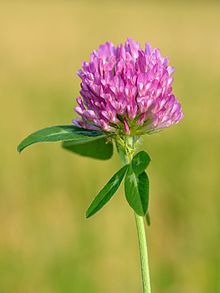Meadow clover
| Meadow clover | ||||||||||||
|---|---|---|---|---|---|---|---|---|---|---|---|---|

Meadow clover ( Trifolium pratense ) |
||||||||||||
| Systematics | ||||||||||||
|
||||||||||||
| Scientific name | ||||||||||||
| Trifolium pratense | ||||||||||||
| L. |
The meadow clover ( Trifolium pratense ), also called red clover , is a species of plant from the genus clover ( Trifolium ) in the subfamily of the butterflies (Faboideae) within the family of the leguminous plants (Fabaceae or Leguminosae).
description

Vegetative characteristics
The meadow clover is a one to two year old or hibernating green, perennial herbaceous plant that reaches heights of 15 to 80 centimeters. The upright or ascending stem is hairy bald to tightly pressed.
The alternate and spirally arranged leaves are divided into a petiole and a leaf blade. The petiole is 1.8 to 8.6 inches long. The leaf blade is pinnate in three parts, also called fingered. The leaflets, which are finely haired on both sides, are 18 to 60 millimeters long and 8 to 35 millimeters wide, ovate to elliptical with a rounded base and oblong in the upper area; they have a lighter spot in the middle. The edge of the leaflet is smooth. The egg-shaped to lanceolate stipules are fused with the petiole, the free part is awn-like, much shorter than the fused lower part and glabrous or hairy.
Generative characteristics
The flowering period extends from April / May to October. There are many-flowered, spherical to egg-shaped spiked inflorescences that have a length of 1 to 2 centimeters and a diameter of 2 to 3 centimeters. The inflorescence is mostly covered by the uppermost stem leaves.
The hermaphrodite flowers are zygomorphic and five-fold with a double flower envelope . The five sepals are fused. The ten-nerved calyx tube is only slightly hairy. The unequal calyx teeth are ciliated. Some of the five red petals are fused. The crown has the typical shape of a butterfly flower and is 10 to 18 millimeters long. The single carpel is on top.
The legume is 1.5 to 4 millimeters long and up to 1 millimeter wide and contains one or two seeds.
The number of chromosomes is 2n = 14.
ecology

The meadow clover is a hemicryptophyte and stem plant with a strong rhizome and migratory roots. It is deep-rooted and roots up to 2 meters deep. Vegetative reproduction occurs through underground runners .
Even the cotyledons perform day and night movements by collapsing at night. The feathers of the leaves swing in the dark in an approx. Three-hour rhythm (autonomous turgor movement).
From an ecological point of view, these are nectar-bearing butterfly flowers with a folding mechanism. They are mostly pollinated by "long-nosed" bumblebees and other Apidae ; the nectar is at the bottom of a 9 to 10 mm long tube; the honey bee (proboscis length 6 to 6.5 mm) can only collect pollen ; Bombus terrestris L. (trunk length 7 to 9 mm) commits nectar theft by breaking in from the side; the holes bitten by the bumblebee in the corolla tube are also used by honey bees. However, the pollination performance of long-nosed bumblebees is much higher. In several countries there has been a dramatic decline in these bumblebee populations, so that the average seed yield is falling and is also subject to strong fluctuations. Spontaneous self-pollination does not lead to seed formation; Bumblebees were introduced to New Zealand so that the cultivated meadow clover could reach seed maturity; in North and South America, the meadow clover , which is also not native, is pollinated by birds (in North America for example by Archilochus colubris ).
The tiny one- to two-seeded fruits pop open with a lid. The hairy calyx remains, and the ciliate calyx tips, together with the dry corolla, serve as a flight organ (umbrella flyer and wing flyer). Incidentally spreading by grass-eaters, spreading by ants and spreading by earthworms (a type that has so far been neglected) The fruit ripens from August to October. The hard-shell seeds can germinate for at least 14 years (under favorable conditions more than 100 years).
Occurrence
The meadow clover can be found in fat meadows, in fields and in sparse forests, and it is also cultivated as a crop. He prefers fresh, nutrient-rich, deep clay and loam soils and loves lime and sulfate. The meadow clover thrives on the colline to alpine level ; in the Central Alps it rises to altitudes of 2600 meters (there its own subspecies). In the Allgäu Alps the subspecies Trifolium pratense subsp. nivale at the summit of the Nebelhorn in Bavaria up to an altitude of 2240 meters, the subspecies Trifolium pratense subsp. pratense in the Allgäu over 2000 meters.
According to Ellenberg , it is a class character type of the grassland societies (Molinio-Arrhenatheretea). But it also occurs in companies of the Trifolion medii association.
Systematics
Trifolium pratense was first published in 1753 by Carl von Linné in Species Plantarum . It is the lectotype species of the genus Trifolium . A synonym of Trifolium pratense L. is Trifolium pratense var. Sativum Schreb. Trifolium pratense belongs to subsection Trifolium of Section Trifolium in the genus Trifolium .
There are three subspecies of the meadow clover ( Trifolium pratense ) in Central Europe:
- Coastal clover ( Trifolium pratense subsp. Maritima (Zabel) Rothm. )
- Alpine clover ( Trifolium pratense subsp. Nivale (WDJ Koch) Arcang. )
- Usually red clover ( Trifolium pratense L. subsp. Pratense )
ingredients
Red clover contains in particular rhodanide , cyanogenic glycosides , phytoestrogens ( isoflavones , also present in ensiled forage) and possibly nitrates . The protein content is high; it also contains protease inhibitors .
Veterinary toxicological effects
All green parts of plants can be poisonous, depending on the season and the weather, due to changes in the secondary metabolism and depending on the amount fed; but this is seldom the case. Generally, clover species are good forage plants.
The toxic effect is based on the following mechanisms:
- soluble proteins are believed to be responsible for frothy fermentation in the rumen ;
- The hydrogen cyanide released from the cyanogenic glycosides inhibits cytochrome oxidase and thus blocks the respiratory chain in the mitochondria (causing a lack of oxygen in tissues, cramps);
- by phytoestrogens can cause fertility problems and miscarriages;
- Nitrate is converted to nitrite , which oxidizes hemoglobin to methemoglobin , which reduces the oxygen content in the blood;
- Photosensitization through the dye rhodanide (trifoliosis, clover disease).
Pharmacological effects
Due to the content of isoflavones (especially Pratensein , Formononetin , Biochanin A ), preparations made from the flowers of the meadow clover ( Trifolii pratensis flos ) should reduce menopausal symptoms in women. The substances bind to estrogen receptors and can develop estrogen-like effects, which is why they are also referred to as phytoestrogens . A number of preparations ( dietary supplements ) are available on the market, effectiveness is almost completely derived from epidemiological findings and has not been adequately proven by studies.
use
The meadow clover is a protein-rich forage plant and has been cultivated in Germany since the 11th century, but clover cultures were only widespread after 1750. Due to the symbiosis with nitrogen-fixing bacteria (nodule bacteria) it is very suitable as a soil conditioner and as a previous crop for other crops; For beekeeping , varieties with a shorter corolla tube were bred out. Mixed with other types of clover and grass , it is used as grass clover for green manure and as an alternative to maize in biogas plants .
swell
literature
- Siegmund Seybold (Ed.): Schmeil-Fitschen. Interactive flora of Germany. Seeing - determining - knowing. The key to the flora . CD-ROM, version 2.0. Quelle & Meyer, Wiebelsheim 2004, ISBN 3-494-01368-3 .
- Ruprecht Düll , Herfried Kutzelnigg : Pocket dictionary of plants in Germany. A botanical-ecological excursion companion to the most important species . 6th, completely revised edition. Quelle & Meyer, Wiebelsheim 2005, ISBN 3-494-01397-7 .
- Margot Spohn, Marianne Golte-Bechtle: What is blooming there? The encyclopedia: over 1000 flowering plants from Central Europe. Kosmos, Stuttgart 2005, ISBN 3-440-10326-9 .
- Rolf Wisskirchen, Henning Haeupler: Standard list of fern and flowering plants in Germany. With chromosome atlas . Ed .: Federal Agency for Nature Conservation (= The fern and flowering plants of Germany . Volume 1 ). Eugen Ulmer, Stuttgart (Hohenheim) 1998, ISBN 3-8001-3360-1 .
- Meadow clover. In: FloraWeb.de.
Individual evidence
- ↑ Jörg Mildenberger: Anton Trutmann's 'Pharmacopoeia.' Part II: Dictionary (= Würzburg medical historical research. Volume 56). Würzburg 1997, p. 2308.
- ↑ a b c d e f meadow clover. In: FloraWeb.de.
- ↑ a b Erich Oberdorfer : Plant-sociological excursion flora for Germany and neighboring areas . 8th edition. Verlag Eugen Ulmer, Stuttgart 2001, ISBN 3-8001-3131-5 . Page 595-596.
- ↑ Riccardo Bommarco, Ola Lundin, Henrik G. Smith, Maj Rundlöf: Drastic historic shifts in bumble-bee community composition in Sweden. In: Proceedings of the Royal Society B Biological Sciences. Volume 279, No. 1727, 2012, pp. 309-315, doi : 10.1098 / rspb.2011.0647 .
- ↑ Erhard Dörr, Wolfgang Lippert : Flora of the Allgäu and its surroundings. Volume 2, IHW, Eching 2004, ISBN 3-930167-61-1 , p. 134.
- ↑ Carl von Linné: Species Plantarum. Volume 2, Lars Salvius, Stockholm 1753, p. 768, digitized
- ↑ Trifolium pratense at Tropicos.org. Missouri Botanical Garden, St. Louis, accessed September 5, 2013.
Web links
- Meadow clover. In: FloraWeb.de.
- Meadow clover . In: BiolFlor, the database of biological-ecological characteristics of the flora of Germany.
- Profile and distribution map for Bavaria . In: Botanical Information Hub of Bavaria .
- Trifolium pratense L. s. l. In: Info Flora , the national data and information center for Swiss flora .
- Distribution in the northern hemisphere from: Eric Hultén, Magnus Fries: Atlas of North European vascular plants. 1986, ISBN 3-87429-263-0 at Den virtuella floran. (swed.)
- Thomas Meyer: Data sheet with identification key and photos at Flora-de: Flora von Deutschland (old name of the website: Flowers in Swabia )
- Trifolium pratense at Plants For A Future
- Trifolium pratense inthe IUCN 2013 Red List of Threatened Species . Posted by: L. Lopez Poveda, 2012. Retrieved September 3, 2013.
Overview presentations
Agriculture
pharmacology
- www.foodtech.uni-kiel.de (PDF file; 138 kB)







